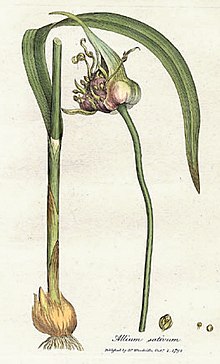
Back Knoffel Afrikaans ነጭ ሽንኩርት Amharic Allium sativum AN Garleac ANG ثوم Arabic توم ARZ নহৰু Assamese Allium sativum AST Ajusa Aymara Sarımsaq Azerbaijani
| Garlic | |
|---|---|

| |
| Allium sativum, known as garlic, from William Woodville, Medical Botany, 1793. | |
| Scientific classification | |
| Kingdom: | Plantae |
| Clade: | Tracheophytes |
| Clade: | Angiosperms |
| Clade: | Monocots |
| Order: | Asparagales |
| Family: | Amaryllidaceae |
| Subfamily: | Allioideae |
| Genus: | Allium |
| Subgenus: | A. subg. Allium |
| Species: | A. sativum
|
| Binomial name | |
| Allium sativum | |
| Synonyms | |
|
Synonymy
| |
Garlic (Allium sativum) is a species of bulbous flowering plant in the genus Allium. Its close relatives include the onion, shallot, leek, chive,[2] Welsh onion, and Chinese onion.[3] It is native to Central Asia, South Asia and northeastern Iran.[4][5] It has long been used as a seasoning and culinary ingredient worldwide, with a history of several thousand years of human consumption and use, including also use as a traditional medicine. It was known to ancient Egyptians[6] and other ancient cultures for which its consumption has had a significant culinary cultural impact, especially across the Mediterranean region and across parts of Asia.[7][8][9] It is produced globally but the largest producer is China which produced 73% of the world's supply of garlic in 2021. There are two subspecies and hundreds of varieties of garlic.
- ^ "Allium sativum L". Kewscience; Plants of the World Online; Royal Botanic Gardens, Kew, England. Retrieved May 26, 2017.
- ^ Block, Eric (2010). Garlic and Other Alliums: The Lore and the Science. Royal Society of Chemistry. ISBN 978-0-85404-190-9.
- ^ "Substance Info: Garlic". All Allergy. Zing Solutions. Archived from the original on June 15, 2010. Retrieved April 14, 2010.
- ^ "Allium sativum L." Plants of the World Online | Kew Science. Retrieved October 31, 2018.
- ^ Block, Eric (2010). Garlic and Other Alliums: The Lore and the Science. Royal Society of Chemistry. pp. 5–6. ISBN 9780854041909.
- ^ Cherry, Robin (November 11, 2014). Garlic, an Edible Biography. Boston: Shambhala Publications. p. 12. ISBN 978-1-61180-160-6.
- ^ Pellechia, Thomas (2000). Garlic, Wine, and Olive Oil. Booklink. ISBN 978-0-88496-444-5.
- ^ Newman, Jacqueline (August 30, 2004). Food Culture in China. Bloomsbury Publishing USA. ISBN 978-0-313-08572-7.
- ^ Cherry, Robin (November 11, 2014). Garlic, an Edible Biography. Boston: Shambhala Publications. p. 16. ISBN 978-1-61180-160-6.